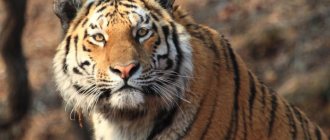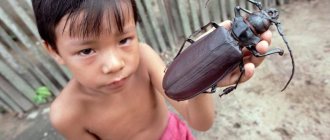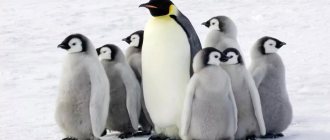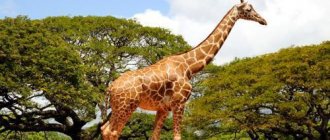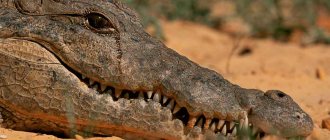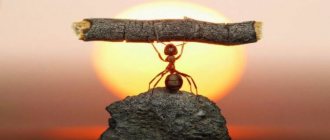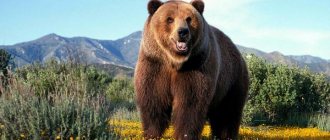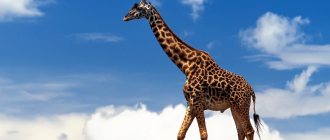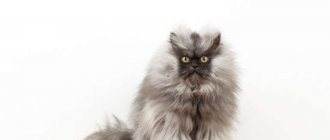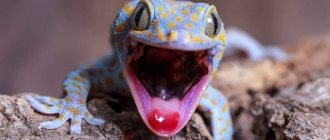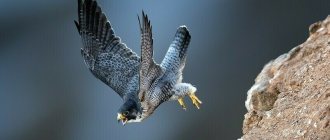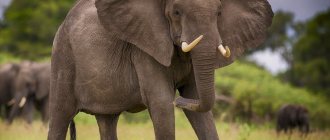Bears are large terrestrial predators, represented by a large list of species, and living in the spaces of Eurasia and North America. Bears eat more than just meat—most species are omnivores. Their unpretentiousness in food, as well as their high adaptability to a wide variety of conditions, allowed them to spread widely and gain a foothold as top predators in many ecosystems.
For thousands of years, the bear has coexisted with humans, causing awe and fear. There was even an interesting Slavic belief that placed the bear as the closest animal to humans - due to the ability to walk on its hind legs, love for sweets, anatomy close to humans - and in particular, the structure of the fingers. It is also worth noting the exceptional intelligence of these animals.
Prehistoric bears
Comparison of the short-faced bear and humans
According to paleontologists, bears appeared approximately 7 million years ago, and after 2 million they settled over a large area, forming several species. The largest of them turned out to be a short-faced bear. An extinct giant with a height of up to 2-3 meters at the withers , weighing up to 1400 kg or more. These huge predators lived during the Ice Age, when gigantism among mammals was very common. There were other ancient bears of large sizes, but they all became extinct, and therefore it is worth moving on to their large descendants.
Giant heavyweights
As you already understand, the brown bear, which we describe in this article, is the most common species of clubfoot all over the world. Although it is called brown, it is not always painted exactly this color. In nature you can find black, beige, yellow, and even fiery red bears. But we'll talk about the color of their fur a little later. Now we are interested in their sizes.
The sizes of these animals vary depending on their gender, age and habitat. But males are in any case larger than females and weigh 30% more. Most brown bears have a height at the withers ranging from 75 to 160 centimeters. Body length generally ranges from 1.6 to 2.9 meters.
The weight of a brown bear directly depends on its habitat. One of the largest animals are bears that live on the Scandinavian Peninsula and, of course, on the territory of our country. Their weight is 350 kilograms. Their American relatives, living on the west coast of the United States and also inhabiting Canada, can sometimes weigh more than 400 kilograms of net weight. Their name is grizzly, or gray-haired.
The brown bear, whose size is considered impressive throughout the world, is also found in Kamchatka and Alaska. There, these predators weigh more than 500 kilograms. Cases of hunting brown bears are described, supposedly reaching a weight of 1 ton! However, for the most part, these furry heavyweights do not exceed 350 kilograms of net weight. The maximum recorded weight, for example, of a Kamchatka bear was 600 kilograms. The animals preserved in Europe are small in size. Their weight does not exceed 90 kilograms.
Kermode is neither an albino nor a polar bear
Kermode, or Kermode bear
Not everyone knows about the existence of the Canadian Kermode bear, called the ghost bear by local Indians. These are unusual and very beautiful representatives of the bear family, with white or cream hair. The Kermode's habitat is not large; they live only in the forests of western Canada, which are located near the coast. You might think that this species has some relationship with white polar bears, but this is not the case. They are not similar either in their lifestyle or in any other features, and are very different in appearance. Keromdas can weigh 230-300 kg with a height of about 180 cm (an adult, on its hind legs) .
Interesting: Why is a polar bear white? Photo and video
Spreading
As mentioned earlier, bears are forest dwellers. Let us repeat that their typical habitats, for example, in Russia, are continuous forests with dense growth of grasses, shrubs and deciduous trees. The brown bear, a brief description of which we are considering in this article, is found in both tundra and high-mountain forests. In Europe, it prefers mountain forests, and, for example, in North America it can be found in alpine meadows and coastal forests.
Once upon a time, these animals inhabited the whole of Europe, including Ireland and Great Britain, and in the south of the globe its habitat reached the African Atlas Mountains. To the east, this species of furry heavyweights was distributed through Siberia and China to Japan. Scientists believe that brown bears came to North America from Asia about 40 thousand years ago. They are confident that these animals were able to independently cross the Bering Isthmus, settling in the west of America from Alaska to Mexico.
Baribal - black bear
Baribal
Baribals are more widespread. This is also an American bear, whose domains start from Alaska and extend to Canada and the USA. Most often, they spend their lives in the forest, only occasionally going out into open areas - and then only in search of food. Bears live solitary lives, but during the period of childbirth, females can create groups to care for cubs - this is similar to a kind of kindergarten. Baribals choose mainly vegetarian food, which does not prevent them from periodically feasting on fish and meat. The growth of the forest giant reaches 2 meters (an adult, on its hind legs), weight is 330-360 kg .
Hibernation
In most cases, adult animals while away the cold winter days in their dens alone. Only a female bear can hibernate with last year’s cubs. Scientists who observed the life of these predators (see photo of a brown bear and a description of its lifestyle) noticed that in certain areas of the globe, where there are no particularly suitable places for wintering, bears use the same shelters several times.
In some areas, dens can generally be located in close proximity to each other, resulting in something like a bear “apartment” building. If the choice of “winter apartments” is very difficult, some particularly arrogant bears encroach on other people’s homes. For example, an adult male brown bear can, without any pity, expel a weaker relative from a den he likes.
Brown bears sleep curled up. They tuck their hind legs to their belly, and cover their muzzle with their front legs. By the way, it was this fact that gave rise to many tales and sayings that bears suck their paws in winter. This is not entirely true. Clubfoot animals, of course, can lick their front paws from time to time, while in one phase or another of sleep, but this has absolutely nothing to do with their sucking.
Brown grizzly
Brown grizzly
Grizzly is the largest of the American bears; you can meet him in Alaska and in a number of American states. Such a meeting will not please you, because some individuals reach 450 kg or more in weight, with a height of up to 2.3 meters (an adult, on its hind legs)! Grizzlies are similar to European brown bears, differing only in habits and behavior. This is a dangerous bear for humans; stories about tragic encounters with it appear every year. By nature, the animal is omnivorous; its diet consists of plant and animal foods approximately 50/50.
Population status
Due to their wide distribution and habitat in remote areas, it is very difficult to determine the exact number of brown bears today. According to rough estimates, there are 200-250 thousand of these animals in the world. This seems like a fairly large number, but we must not forget that many populations are extremely small and are in danger of extinction. Tiny remnant populations are scattered throughout Spain, Italy, France, and Greece. Brown bears were brought to some areas of France, Austria, and Poland from other places. Restoration of small populations is difficult due to the low reproduction rate.
The conflict with humans, the only enemy of brown bears, is aggravated by the fact that each bear uses a very large territory. In Russia, Japan and some European countries, hunting of brown bears is allowed. In our country, for example, 4-5 thousand animals are killed annually. This level of legal shooting is considered acceptable, but there is still the problem of poaching.
Most populations are listed on CITES Appendix II, with the Chinese and Mongolian populations listed on CITES Appendix I. American populations found in Alaska are listed as rare by the IUCN.
- Black bear (baribal)
- Types of bears
- Dipper Butterflies
- Wolverine - photo,...
- Types of elephants
- Red-haired nocturnal
Siberian brown bear
Siberian brown bear
Huge brown bears live in Siberia; in the summer they actively consume plant and animal food, and in the winter they sleep in dens. In dens, in winter, female bears give birth to a new generation. Subsequently, the cub remains with its mother for three years, growing up and learning to hunt. Large males are more than 2.5 meters tall (adult, on their hind legs), and their weight reaches 800 kg.
Interesting: The most dangerous bears - list, names, descriptions, photos and videos
Kodiak is the largest brown bear
Kodiak - the largest brown bear
Kodiaks are record holders among brown bears, reaching three meters in height and weighing 850-1000 kg. This is an endangered species living in the Kodiak archipelago and in need of protection - no more than 3 thousand individuals remain.
This type of bear is also omnivorous. However, they have great difficulty adapting to changing conditions, and therefore do not take root well in zoos.
The biggest bears on Earth: top 10
In addition to the brown and polar bear, there are several other large varieties of this animal. Most of them pose a danger to humans.
Figure 2. There are quite a lot of large bears
Large species of bears include:
- Polar bear: with a body weight of about a ton and a body length of 3 meters, this predator is an excellent hunter and gets its food in the coldest parts of the planet. This predator lives in Norway, Greenland, Russia, Canada and Alaska. The largest bear in the world feeds on ringed seals, walruses, sea hares and fish.
- Kodiak: The name of this subspecies of bear comes from its natural habitat, namely the Kodiak Archipelago on the shores of Alaska. Kodiaks are very shy animals and when meeting people, they most often run away from “uninvited guests.”
- Grizzly bears: as adults they are of impressive size and can eat many foods (berries, fish, animals) that they find or catch in their natural habitat. Grizzlies can be distinguished from other subspecies of bears by the presence of a prominent hump on their back and long claws. There were numerous recorded cases of grizzly bears attacking humans, and he went down in history as the “Man-Eating Bear.”
- Brown bear: lives in Western and Central Europe, Scandinavia, the Carpathians and Finland. In the vastness of Russia, brown bears can be found in almost the entire forest zone with the exception of the southern regions. The bear eats a lot of the food that a person eats in life. Also, this animal can stand steadily on its hind legs or hold in its paws various objects that it finds in the forest.
- Baribal “black bear”: has a black coat color and can be considered peaceful towards humans, since it almost never attacks people. In some cases, the beast attacked livestock, but this happened extremely rarely. This subspecies of bear feeds on plants, berries and fish.
- Kermode bear: lives in the western forests of Canada and has a reddish-white color, which helps the animal to fish in rivers and hide in forests. The animal is large, but when meeting a person it prefers to hide by running.
- Giant Panda: This is a cute and peaceful bear that eats only bamboo. To do this, there are 6 toes on its front paws.
- Himalayan bear: short, silky black fur grows on the body of the animal and there is a characteristic white crescent-shaped spot on the chest. This mammal feeds mainly on plant foods and shellfish, but when it encounters a person it can attack him. The Himalayan bear lives in the regions of Asia.
- Spectacled Bear: Due to its appearance, this animal has received the nickname “Intellectual Bear”, since under its eyes there are rings of a lighter shade, reminiscent of glasses. The animal feeds mainly on plant foods and, in search of food, can even climb to the top of a tree for fruits. This subspecies of bears is the only one that does not hibernate in a den.
- Sloth Bear: The appearance of this subspecies of bear absolutely corresponds to its name. The animal's head, nose and eyes resemble a sloth. But from a distance the lips of a sponger can resemble a trunk. This subspecies of bears feeds on termites and ants. When the need arises to profit, the animal extends its lips forward into a tube shape and blows away the dust from the anthill, after which it sucks up the insects. This process is accompanied by a loud whistle.
Figure 3. Even little-known varieties of clubfoot are impressive in size
In Russia
The territory of Russia is huge in area and is home to a large number of different animals, including bears. Brown bears have the largest population in the forests of Russia and number about 200 thousand individuals. Recently, the number of brown bears has been gradually increasing, since they are under the protection of the Russian government and are listed in the IUCN Red List.
The biggest bear in the world
Polar bear
The largest bear in the world is the polar bear . The weight of a male can exceed a ton, and his height up to 3 meters (an adult, on his hind legs), although some bears significantly exceed these figures and turn out to be complete giants. Polar bears are perfectly adapted to life in the polar regions and on the islands of the Arctic Ocean, inhabiting places where there are practically no people, or living next to humans.
The polar bear feeds on fish, seals and other available food - it would not be easy for him to live with vegetarianism in northern latitudes. Read our article: why polar bears don't eat penguins. These bears also know how to hibernate, but their hibernation is short-lived - especially for males, who do not sleep for long at all. Pregnant females sleep longer.
Polar bears are very smart animals, characterized by curiosity. Under their white fur, which dries easily after swimming in the sea even in the cold, they have black skin that absorbs maximum heat from the sun (read our article: why the polar bear is white). They can also walk on their hind legs, using their entire foot, like a human - other animals cannot do this.
Interesting: Why don't polar bears eat penguins? Reasons, photos and videos
Bears are one of the largest predators on the planet (the largest land animals). And despite all their power and size, they also need protection. Many of their species are on the verge of destruction, but measures to protect them are being taken and implemented. I would like to believe that in the future the number of endangered species will increase, and their habitat will become more environmentally protected.
Appearance
The brown bear, the dimensions of which we discussed above, has a pronounced barrel-shaped and powerful body with high withers (height at the shoulders). This body is supported by massive and high paws with flat, clawed soles. The length of the claws of this shaggy giant ranges from 8 to 12 centimeters. These animals practically do not have a tail, since its length does not exceed 21 centimeters.
The shape of the brown bear's head is round. There are small blind eyes and small ears on it. The muzzle is elongated and the forehead is high. The owner of the Russian taiga is covered with thick and evenly colored fur. The coloring of brown bears, like their size, is variable. It all depends on the particular habitats of these animals. For example, famous grizzly bears can have brown fur with a silver tint. For this, by the way, they were called gray-haired.
Features of wintering
All winter the bear sleeps on its side, curled up comfortably. Poses on the back or sitting with the head down are less common. Breathing and heart rate slow down during hibernation.
Surprisingly, this animal does not defecate during winter sleep. All waste products in the bear's body are reprocessed and converted into valuable proteins necessary for its existence. The rectum is closed by a dense plug consisting of pine needles, compressed grass and wool. It is removed after the animal leaves the den.
Offspring
The young are born blind, with overgrown ear canals and covered with short, sparse hair. After two weeks, the cubs begin to hear, and after a month - to see. Within 90 days after birth, all of their baby teeth grow in and they begin to eat berries, plants and insects. As a rule, male brown bears do not raise offspring; raising young animals is the prerogative of females. Bear cubs become sexually mature by the age of 3, but continue to grow until they are 10 years old.
Reproduction
Female brown bears give birth 2 to 4 times a year. Their mating season usually falls in May, June and July. At this time, the males behave aggressively: they begin to roar loudly, serious fights arise between them, sometimes ending in the death of one of the bears. Pregnancy in females lasts from 190 to 200 days. At one time they can bring up to 5 cubs with a body weight of up to 600 grams and a length of up to 23 centimeters.
Nutrition
Despite their predatory breed, the main source of food for brown bears is vegetation. As a rule, they feed on nuts, berries, acorns and stems of various plants. Do not pass by insect nests.
From the animal world, I don’t mind eating mice, gophers and chipmunks. During the period before hibernation, the brown bear is able to take prey from other predators. Its diet may include carcasses of fallow deer, roe deer, elk and deer.
